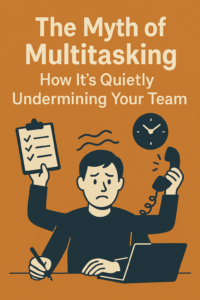Ever feel like there aren’t enough hours in the day? You’re not alone. Between back-to-back meetings, endless emails, and actual work that needs doing, modern professionals are facing a time crunch like never before. I’ve spent years perfecting my approach to time management, and I’m sharing the techniques that have genuinely made a difference.
The problem isn’t just about being busy—it’s about being effective with the limited time we have. According to a study by McKinsey, the average professional spends 28% of their workweek managing emails and nearly 20% searching for information. That’s almost half your work hours!
Let’s cut through the fluff and get to what actually works.
1. Time Blocking: Own Your Calendar
Time blocking isn’t just another productivity trend—it’s a game-changer. Rather than working from a never-ending to-do list, you actually schedule specific blocks of time for different activities.
I resisted this technique for years. “My schedule is too unpredictable,” I told myself. Then I realized that was precisely why I needed it.
Here’s how to make it work:
- Dedicate 30 minutes each Friday to map out your next week
- Block 90-120 minute chunks for deep work
- Include buffer time between meetings (trust me on this one)
- Create a “miscellaneous” block for unexpected tasks
Cal Newport, author of Deep Work, explains that time blocking forces you to confront the reality of finite hours. When you see your day mapped out, you make more intentional choices about where your time goes.
2. The Pomodoro Technique: Work With Your Brain, Not Against It
Named after a tomato-shaped kitchen timer, this technique works with your brain’s natural attention span.
The basic framework:
- Work intensely for 25 minutes
- Take a 5-minute break
- After four cycles, take a longer 15-30 minute break
What makes this different from just “working in bursts” is the psychological commitment to focus during those 25 minutes. No checking email, no social media—just focused work on a single task.
On days when my motivation is lagging, Pomodoro gets me started because I know I only need to commit to 25 minutes. Usually, by the first break, I’ve built enough momentum to keep going.
3. The Eisenhower Matrix: Urgent vs. Important
Ever find yourself putting out fires all day only to realize you haven’t touched your priority work? The Eisenhower Matrix helps solve this common predicament.
Divide tasks into four quadrants:
- Urgent and important (do immediately)
- Important but not urgent (schedule time)
- Urgent but not important (delegate)
- Neither urgent nor important (eliminate)
The magic happens in quadrant two—important work that isn’t screaming for immediate attention. These tasks often include strategic planning, relationship building, and personal development. According to research from Harvard Business Review, professionals who spend more time in this quadrant report higher levels of productivity and job satisfaction.
4. The 2-Minute Rule: Small Wins Matter
I picked this up from David Allen’s “Getting Things Done” methodology, and it’s beautifully simple: if something takes less than two minutes, do it now.
The reasoning is sound—the mental overhead of tracking, remembering, and eventually doing that small task often exceeds the effort of just handling it immediately.
Examples include:
- Responding to straightforward emails
- Scheduling that appointment you’ve been putting off
- Filing that document instead of adding it to the pile
Just be careful not to let these two-minute tasks derail your deep work periods. I designate specific times during the day for catching these small items, usually during energy lulls.
5. Weekly Review: The Missing Link in Most Systems
This might be the least sexy technique on the list, but it’s arguably the most transformative. Every Friday afternoon, I spend 30-45 minutes reviewing what worked, what didn’t, and adjusting my approach for the coming week.
My review includes:
- Checking progress on major projects
- Reviewing missed tasks and rescheduling them
- Identifying time drains from the past week
- Setting 3-5 priorities for the upcoming week
Research from the American Psychological Association shows that this kind of systematic reflection improves performance more effectively than simply gaining additional experience.
The weekly review prevents your time management system from breaking down, which is why most productivity systems eventually fail.
6. Single-Tasking: The Multitasking Myth
Despite what we tell ourselves, humans are terrible at multitasking. What feels like doing two things at once is actually rapid switching between tasks, which psychology research shows can reduce productivity by up to 40%.
I learned this lesson the hard way during a project that nearly went off the rails. Now:
- I close all unrelated browser tabs when working on a specific task
- I use the “Do Not Disturb” feature on my devices
- I batch similar activities (emails, calls, creative work)
- I keep a “distraction notes” document open to jot down random thoughts without derailing focus
The hardest part is breaking the habit of checking email or Slack every few minutes. It took me about two weeks of conscious effort before single-tasking started feeling natural.
7. Energy Management: Work With Your Natural Rhythms
Not all hours are created equal. I’ve discovered that managing my energy is just as important as managing my time.
Through trial and error, I’ve learned:
- My analytical thinking peaks before noon
- Early afternoons are best for meetings and collaborative work
- Creative work flows better after 3pm
- Administrative tasks fit well into energy “valleys”
Track your energy patterns for a week and schedule your most important work during your peak hours. According to research published in Chronobiology International, aligning tasks with your circadian rhythm can significantly improve performance.
8. Strategic Delegation: The Art of Letting Go
Perfectionism is the enemy of effective time management. Learning to delegate appropriately has easily doubled my productive output.
Effective delegation isn’t just assigning tasks—it’s a skill that includes:
- Clearly communicating expectations
- Providing necessary resources
- Setting reasonable deadlines
- Establishing check-in points
- Giving appropriate authority along with responsibility
Not everything needs to be done to your exact specifications. Ask yourself: “Is this task the best use of my time and skills?” If not, it’s a candidate for delegation.
9. Digital Boundaries: Taming the Technology Beast
Our devices have become both indispensable tools and extraordinary distractions. Creating boundaries around technology use has reclaimed hours of my week.
Practical steps I’ve implemented:
- Designated email processing times (10:30am, 2:00pm, 4:30pm)
- Notifications limited to truly urgent communications
- Social media apps removed from my phone
- “Screen-free” hours in the evening to improve sleep and recovery
The impact is profound—not just on time management, but on mental clarity. The Journal of Social and Clinical Psychology found that limiting social media use to 30 minutes per day led to significant reductions in loneliness and depression.
10. The Strategic “No”: Protecting Your Most Valuable Resource
Perhaps the most powerful time management technique is learning to say “no” to commitments that don’t align with your priorities.
This doesn’t mean becoming uncooperative. It means being intentional about what you commit to. Every “yes” is implicitly a “no” to something else.
When evaluating requests, I ask:
- Does this align with my current priorities?
- Will this matter in a month? A year?
- Is there someone better suited for this task?
- What would I have to give up to accommodate this?
Learning to say “no” gracefully took practice, but it’s been worth it. I now suggest alternatives, explain my constraints, or offer limited help instead of taking on commitments I can’t fulfill properly.
Finding Your Personal System
These techniques aren’t one-size-fits-all solutions. The most effective approach is developing a personalized system that works with your specific challenges and strengths.
Start by implementing one or two techniques that address your biggest pain points. Give them a genuine try for at least two weeks before evaluating. Productivity systems take time to show results.
Remember that perfect is the enemy of good. A time management system you actually use consistently is infinitely better than an ideal system you abandon after a week.
What time management techniques have worked best for you? I’d love to hear in the comments below.
Frequently Asked Questions About Time Management
How long does it take to form new time management habits?
Research suggests it takes anywhere from 18 to 254 days to form a new habit, with the average being about 66 days. Don’t get discouraged if you don’t see immediate results with new time management techniques. Consistency is key—stick with a method for at least three weeks before deciding if it works for you.
What’s the biggest mistake professionals make with time management?
The biggest mistake is trying to do too much at once. Many professionals attempt to overhaul their entire workflow simultaneously, which often leads to burnout and abandoning the system altogether. Start with one technique that addresses your most pressing pain point, master it, then gradually add more strategies.
How do I handle unexpected interruptions that throw off my schedule?
Build buffer time into your schedule—I recommend adding 15-minute buffers between important tasks and meetings. Also, create a designated “contingency block” of 30-60 minutes each day specifically for handling unexpected issues. If nothing urgent comes up, use this time for your priority tasks.
Can these time management techniques work for different personality types?
Absolutely. The key is choosing techniques that align with your natural tendencies rather than fighting against them. For example, if you’re more spontaneous, strict time blocking might feel too constraining—instead, try theme days or time blocking just your most important tasks while leaving flexibility elsewhere.
How do I know which time management technique to start with?
Identify your biggest time-waster or frustration. If you constantly feel interrupted, start with techniques like Pomodoro or digital boundaries. If you struggle with prioritization, begin with the Eisenhower Matrix. If you feel overwhelmed by too many tasks, try time blocking. Match the solution to your specific challenge.
Do I need special apps or tools to implement these techniques?
While there are countless productivity apps available, none of these techniques require anything beyond basic calendar and note-taking tools. I recommend starting with simple tools you already use before investing in specialized applications. Sometimes a paper notebook and your existing calendar are all you need.
How do I maintain time management discipline when working from home?
Working from home presents unique challenges. Create physical and temporal boundaries—have a designated workspace and established working hours. Use the “commute time” you save for planning and reflection. Be explicit with family members about when you’re working, and use visual signals (like a closed door) to indicate focus time.




